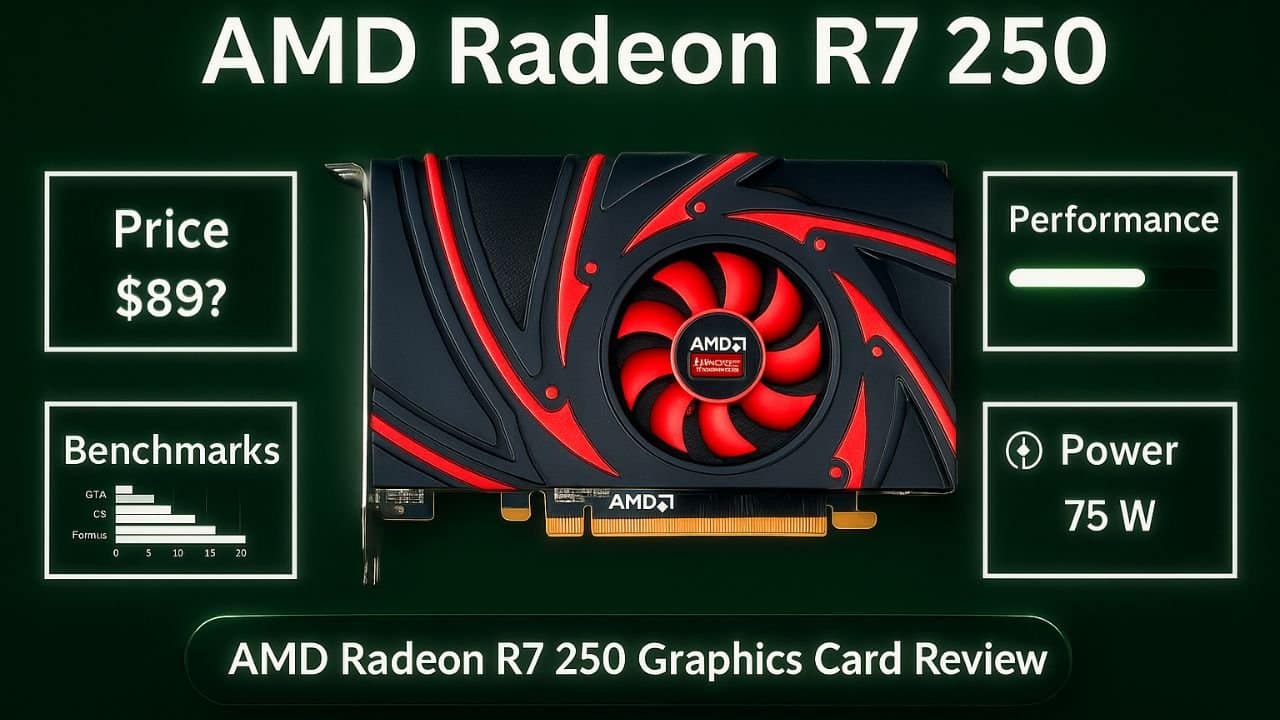If you’re building a super low budget PC, doing light gaming on an older rig, or reviving a dusty machine from 2013, the AMD Radeon R7 250 is a card that keeps popping up in second hand markets. It’s not a powerhouse by modern standards, but for certain scenarios it still has some life left.
Launched in 2013, the R7 250 sat in AMD’s entry-level line. Back then, it was meant for people who wanted “better than integrated graphics” without spending too much. Today, it’s a relic but depending on your expectations, it can still handle older games, 720p play, and everyday tasks.
In this review, I’ll break it all down: specs, prices, temps, power draw, real gaming benchmarks, productivity use, retro/emulation, and finally who should even consider it now.
Specifications
| Feature | Details |
|---|---|
| Architecture | GCN 1.0 (Oland XT) |
| Process Size | 28 nm |
| Launch Date | October 2013 |
| Launch Price | $89 USD |
| Stream Processors | 384 |
| Core Clock | Up to 1050 MHz |
| Memory Type / Size | 1 GB or 2 GB GDDR5 |
| Memory Bus | 128-bit |
| Memory Bandwidth | 72 GB/s |
| TDP (Power Draw) | 75 W |
| Interface | PCIe 3.0 x8 |
| Outputs | HDMI, DVI, VGA |
| APIs Supported | DirectX 12 (FL 11.1), OpenGL 4.x |
Price & Availability
Launch Price
When it first came out in October 2013, the Radeon R7 250 cost around $89. That means it was a cheap starter graphics card, better than the built-in graphics, but not made for high-end gaming.
Current Used Price
Because it’s so old, the R7 250 is only viable now in the used and second hand market. Prices vary widely depending on region, memory variant (GDDR5 vs DDR3), brand (ASUS, Sapphire, etc.), and condition.
- In many markets, you might find it for $20–$50 USD, or even less.
One Redditor said:
The card can play Fortnite in 720p 60fps… my cousin has one.
(Reddit)
So, don’t expect a great investment, you’re mostly paying for something better than nothing.
Thermals (Temperature Performance)
Thermal performance is important because old cards with poor cooling or degraded thermal paste can heat up more, throttle, or become noisy.
From older reviews:
In tests from TechPowerUp and Tom’s Hardware user data, the R7 250 (1 GB GDDR5) generally stays in the mid 60 °C to low 70 °C range under gaming load.
Thanks to its low 75 W TDP, it doesn’t run hot unless your case airflow is poor or the card’s cooler is dusty.
With a clean heatsink and fresh thermal paste, it should stay cool and quiet even during long sessions.
Tip: When buying used, ask for temperature readings or photos of the cooler. Replace thermal paste if possible, and ensure airflow in your case is decent.
Power Consumption & Requirements
One cool thing about old GPUs like the R7 250 is that they don’t need a lot of power.
- It only uses around 65–75 watts of power.
- Most versions don’t need any extra power cable, they get what they need from the motherboard.
- If your power supply is at least 300 watts, it will work just fine in most old or small PCs.
Tip: Use a good power supply so your PC runs smooth and safe.
If you want to learn more about what’s considered safe GPU temperatures, check out our guide on Average Temperature for GPU.
Gaming Performance (Benchmarks & Real FPS)
Some modern benchmarks (via YouTube) show the card hitting 30 FPS in 1080p if settings are reduced heavily. For example:
The R7 250 still does a decent job running recent games at acceptable frame rates around the 30 FPS mark in 1080p, if you switch it to 720p the FPS will nearly double.
So overall, typical performance is 25–40 FPS in less demanding titles, if you drop settings. Modern AAA games will often be into the unplayable range 15–25 FPS or less.
Productivity & Everyday Use
Here the R7 250 actually holds up reasonably well:
- Browsing, office apps, video playback, streaming — no issues at all.
- It can accelerate video decoding and hardware video features (depending on driver) better than many old integrated GPUs.
- Light photo editing or non heavy 3D work will work okay, especially at lower resolutions.
- For anything serious (video editing, 3D modeling, high-res textures), it’s too underpowered by today’s standards.
As a GPU in a basic build, it gives your system a better responsiveness boost compared to just integrated graphics.
Check out GPUs in Multimedia to see how GPUs help in creative workloads.
Playing Old Games & Emulators
This is one of the strong suits of the R7 250 now:
- Retro console emulators (PS2, GameCube, Wii, older handhelds) are well within its ability.
- For older PC games from the 2000s or early 2010s, it often performs great at native resolutions or modest upscales.
- Because these retro titles don’t demand VRAM or ultra-high detail, the limited specs (1-2 GB memory, 128-bit bus) are less of a bottleneck.
So if your goal is to build a retro gaming box or play older titles, the R7 250 can be good value (if cheap and working).
Who Should Buy R7 250
Based on all of the above, here’s where the R7 250 still makes sense and where it doesn’t:
| Good For | Not Recommended For |
|---|---|
| Playing old games (like CS:GO, GTA IV, Skyrim, or Minecraft) | Playing heavy modern games (like Cyberpunk 2077, Warzone, or GTA V on high settings) |
| Watching movies or YouTube in HD | 4K gaming or video editing |
| Using for school work or office tasks | VR or AI-based apps |
| Building a low cost PC for kids or beginners | Building a high-end gaming rig |
| Retro gaming setups and emulators | Competitive eSports gaming |
Pros and Cons
| Pros | Cons |
|---|---|
| Stays cool and quiet | Can’t play new heavy games |
| Uses very little power | Runs slower than new cards |
| Makes old PCs faster | It’s an old model, not made anymore |
| Good for older games | Some drivers may not work well on new Windows versions |
| Cheap and easy to find | Newer cards give more FPS and better graphics |
What We Think…
If you find the R7 250 in $20–$50 USD, it’s a nice little GPU to play around with. It’s great for older games, videos, and basic PC tasks. It doesn’t need much power and stays cool, so it’s perfect for small or old computers.
But if you want to play new games like Fortnite or Warzone, it will feel slow and laggy. In that case, it’s better to save a bit more and get something newer like the RX 570 or GTX 1050.
Still, the R7 250 is a simple, quiet, and reliable card. It’s a good choice for beginners or anyone who wants to give an old PC new life.
If you’re thinking about upgrading from the R7 250, the NVIDIA RTX 5090 shows how far GPU technology has come.

